Chapter 5 >
Autobiography home >
NF-104 home

|
|
|
Chapter 2 Aerial Combat |
|
Chapter 3 Flight Test |
| Chapter
4 Approach to Space |
|
Chapter 5 Limited Weapons, Assured Defeat! |
|
Chapter 6 Limited War: Unlimited Sacrifices & Defeat t/c |
|
Chapter 7 End of the Beginning t/c |
|
Chapter 5 - Limited Weapons, Assured Defeat click on the links below for more of the story... i. Limited Feedback - ii. Back to School - iii. 388 Tactical Fighter Wing - iv. Rolling Thunder - v. Rules by Fools - vi. The Bridge - vii. Good Morning Vietnam! - viii. Home Again |
||||||||||||||
Limited FeedbackAir Force Systems Command, H.Q., Andrews AFB, MD, May ’65 to Jan ‘67 I was directed to report as a Systems Command Flying Safety Officer at the H.Q. on Andrew Air Force Base, outside Washington, D.C. I presume they didn’t know much about Lt. Col. Smith, because me in flying safety at headquarters seemed analogous with assigning Al Capone as warden on his arrival at Alcatraz. Flight test at Edwards had been the most rewarding situation in my career to that point only, in terms of satisfaction, but most damaging for any future with the Air Force. In terms of promotion, beyond repair. I had received two annual Officer Efficiency Reports (performance ratings) endorsed by Col. Guy Townsend. The words were not terribly damning, but the numerical summations held sway in promotion boards and those were the kiss of death. The AST project, which was my premier flying experience was a root cause, I learned one night in the Officers club, when Don Sorlie our Fighter Chief had many too many. My selection for that test program over his choice, another of our classmates and his best friend was really stuck in his craw, and he wrote all my OERs at Edwards. I had my first thoughts of not going beyond 20 years, but decided to take action to attempt to negate those ratings. No matter the outcome, a three-year lapse in the record would be almost as certain for pass over to promotion as bad reports, but I would gain a measure of satisfaction. I wrote two people, as required for disclaimers to submit to headquarters Air Force. The first was Colonel Clayton L. Peterson, our Director at that time. He was unaware of those bad reports, since I never tried to use close relationship to personal benefit. Throughout my career I maintained a principle of never exercising close friendships with a senior officer who was in my line of command, even with a man like Pete, with whom I could have. If I were to succeed it had to be because of what I did, not who I knew. The second was Russ Rogers, a peer in fighter test, with whom I had direct contact throughout that entire tour, and whose honesty and integrity was common knowledge. Both wrote glowing endorsements of my accomplishments and demeanor and the board rescinded all the ratings and ordered them removed from record. Soon after we arrived and bought a home, my parents notified us that a male German Shepherd puppy closely related to our female Sabre, who died at Edwards, was available. I was flying the base T-39s, a twin-engine passenger airplane, for proficiency and volunteered to fly home a couple of Colonel’s, who were on official business in Albuquerque, where I could get the puppy. I took along a small dog travel cage and acquired this handsome little guy. On the way home, he endeared himself to the passengers and soon he was wandering the aircraft and befriending all. He proved to be the equal of his grandfather, who was a champion, and proved to be every bit as smart and trainable as our beloved Sabre. He, being a male, was named Saber and gave us his love and loyalty for the next 12 years. I assured that the flying safety assignment was brief and moved to the Limited Warfare Office of the Systems Directorate, commanded by Maj. Gen. Joseph J. Cody under whom I had worked at Vandenberg. Our office dealt with technical and hardware projects, below aircraft system level, which would support the on-going war in Vietnam, making it more in line with my interests, experience and education.
Shortly after that reassignment, the XB-70 was involved in a fatal crash with another airplane. The bomber was leading a flight formation of 4 jet trainers and fighters when one of them collided with the bomber, downing both airplanes. Unlike the B-70’s pilot, its copilot, Major Carl Cross, could not eject and died at ground impact. NASA’s X-15 pilot, Joe Walker, died instantly when the F-104A he was flying impacted the bomber. An Accident Investigation Board, for technical and safety evaluations was established, as was an independent Collateral Board. The latter type of board had special functions reserved to instances where suspicion of inappropriate action, contrary to regulations might exist, with procedures and authority similar to a civilian court trial. Our boss, Gen. Cody, was appointed as President of the collateral board and a board of very senior colonels was established, along with the command’s adjutant general. Board procedures are very nearly like a court with fully recorded and sworn testimony, by all witnesses. The general was my boss and knew of my Edwards and test background, so I was assigned as the Recorder of the board, with no voting authority, since all board members had to outrank those being tried. My primary duties were logistics and support, including facilities, equipment and personnel, especially skilled court stenographers, since all testimony was sworn and recorded. I was also responsible to interview prospective witnesses and to take sworn depositions of witnesses, when directed by the board, and to author the final report to Air Force Headquarters and the House and Senate Armed Services Committees.
Our board was privy to the progress of the Accident Board, though they were not privileged to ours. The assignment of keeping our board up to speed on the accident analysis befell me also, since I was intimately knowledgeable of the XB-70 from my flights chasing it. It was often necessary for me to brief our board members on the technical aspects, for them to understand all aspects of the situation that they were judging. Assessing the accident was fairly easy, because lacking any evidence to the contrary in a case where witnesses see a wingman fly into a lead, pilot error is concluded absent firm evidence to the contrary. That held here, with a formation consisting of the bomber with two wingmen on each side. From left wing tip to right they were a T-38, an F-4, an F104, NASA airplane piloted by X-15 pilot Joe Walker, and outboard an F-5A. The only connections to these five was that all jet engines in the formation were manufactured by General Electric! That connection would raise the level of political concern from the outset and ultimate the level of impact on personnel, our responsibility. The evidence and conclusions were that Joe Walker gradually drifted out of position (indicating that no problem existed for him) and his high horizontal stabilizer contacted the 70 degree drooped tail (done for photographic impression) and his airplane flipped over to impact the top of the wing of the B-70 with the top of his airplane, landing directly on his cockpit, sliding sideway to sever one entire vertical tail and part of the other, the exploding violently just aft of the bomber. The result was a flat spin of the B-70 for some time, until subsequent failure of the outer wing where it had been impacted and a faster tumbling fall to its crash, carrying Air Force test pilot Carl Cross with it. His ejection capsule had functionally failed due to the centripetal force induced by the spin of such a long fuselage. Rockwell’s test pilot, Al White, ejected safely in his pod, made possible by his slightly earlier ejection sequence, a timeliness that spared his life. Our board was responsible to address blame and punishment associated with all material facts surrounding the approval, legality and conduct of the entire operation in light of the facts that the B-70 and four smaller jets, all powered by General Electric Jet Engines, were flying in planned close formation. A linkage existed with a defense contractor, General Electric, since the intention was to photograph the aircraft in order to gain pictures for publicity, because all 5 aircraft were powered with GE jet engines. The situation was exacerbated by the fact that General Electric leased and paid for a photo chase, a civilian Lear-jet owned by singer Frank Sinatra. Leasing personal airplanes was not sinister, but in this case added even more grist to the newspapers’ mills. The accident became a media event nationwide, over night. The Air Force made a deal in order that both the Senate Armed Services and House Military Affairs Committees agreed not to conduct independent investigations so long as a report of testimony and facts, of acceptable detail, was sent to each committee daily, throughout the extended process. And they required the final report containing findings and punishment, for their approval, before any public announcements of decisions were made. As recorder, I was responsible for assuring that every day’s progress was written edited and dispatched. That report to the committees ended my every day. As soon as our members were assigned we had departed for Edwards AFB, where we conducted the entire process, except for the report. Board hearings began a day after we arrived on base and progressed seven days a week. We headed home, after nearly a month, with the board’s responsibilities complete, except for finalization of the report. That job was strictly mine to write and prepare the report and have it printed. The congressional committees each established watchdogs with rights to intervene but agreed to remain aloof, so long as they received the details from me, daily. This added to my chores, to compile them, after long days of hearings, which I had to attend. I had help from court reporters and a secretary, but nobody else was allowed to be privy to the board discussions. I had long since learned to be prepared for anything so I began outlining the complete report as we progressed, which blended in with the daily reporting. Due to my knowledge of the situation, I was able to anticipate a lot of things that were almost prima facia to the accident itself, as soon as I saw the series of color photographs of the accident. As a result, my outline was pretty well founded as we went along, even before the accident board started reporting their considerations. When we finally returned home exhausted, I hoped for a few days of rest, since I had the final report fairly well in order except that the courtroom reporters were still transcribing a lot of the detailed testimony out in California, which had to be appended. I had reviewed my final report, in draft with our entire board. During the extended process, the board had a very hard time coming to a decision on the culpability of the three colonels and one senior civil servant who were charged. They were all so senior that none had expectations of general rank. Some felt those being tried were scapegoats and punishment was inappropriate under historical precedent. Had it been a civilian trial, it would have been a hung jury. My most important contribution may have been as intermediary and counselor between the divided, since I enjoyed a very good relationship with all of them, and they were truly an honest and dedicated group. I had the advantage, without having to decide the outcome, of seeing the dichotomy. There was no more reason to accuse the defendants, than the General in charge of the Center, who after all was aware of such photo operations, which were historically founded. In those days and to this, the photographs of new military equipment came from honest, traditional cooperation between contractors and the services. I received an unexpected called late on a Friday afternoon and was ordered to have the final report in the hands of the Chairmen of the two congressional committees no later than noon on Monday. We had to also put the report in the hands of the A. F. Chief of Staff before going to the committees. I knew that I had to get a copy to General Schriever also, as Commanding General of Systems Command, he was responsible for all of us involved. Whether I would fail was problematical. We didn’t have all the testimony from California! I called and the final records had been transcribed and put into Air Mail in the last two days. But it was Friday evening and I wasn’t getting much help from the Postal Service, until I got to the top supervisor on duty in Postal Services and, threatened congressional intervention, maybe my biggest bluff in life, but I would have tried. I had gotten the numbered codes of each mailbag from California and the postal services met us at National Airport. We searched through large stacks of mailbags and found every transcript. Conscripting a sizeable group of dedicated people in Systems H.Q. we worked around the clock and I personally delivered the first copy to General Schriever at his home on the base, hours before we had to deliver to the others. The Chief of Staff’s report was carried concurrent with the reports to the Senate and House. I suppose that was one of very few reports that ever reached congressional level without any intervening checks and balances. The report was endorsed by all, but not to the liking of those of us who understood the full reality and wished to think in terms of culpability and fairness, but politics often transcends those. The saddest part about those proceedings for me was that a wonderful friend and great test pilot who was the XB-70 Test Director, Joe Cotton, was blamed, along with the most senior colonel on the base, Deputy Center Commander, as well as a colonel, who was the Public Information Officer, who’s functions limited to interfacing with the media. Also blamed was the Deputy Systems Project Officer (XB-70 D/SPO), a civil servant from Dayton. I saw first hand, how government ‘career lynchings’ were planned and executed when the highest level of politicans are demanding blood. The first justification for cause was improper use of government property to benefit a commercial enterprise. The second was using a commercial airplane, paid for by the contractor to photograph. And the third was allowing a pilot to fly in the formation, who was not qualified, due to lack of currency in formation flying. That addressed the NASA pilot, Joe Walker whose collision with the XB-70 was the cause of the disaster. Here’s how those really stacked up, in order: 1. As to improper use of government property: the military had no funds for publicity, which certainly benefited the government through public information, so such cooperation with industry was the historical norm. The Flight Test Center like other military developers and testers have always done similar things on many major projects and developments, and made articles and photos available to news media. Most often, these efforts were induced or assisted by the military contractors, since all the major ones had offices and hangars on appropriate bases. Publications like Aviation Week thrived on such activity and became the gratis purveyor of public advertisement for the military. It was a case of long standing mutual support and benefit to all, including the taxpayers who underwrite the cost of military capability. 2. Concerning the rental of a commercial aircraft for photos: that assured less direct cost to the Air Force since the photographs for such efforts were often taken by our military photographers flying in test center T-38 or F-104 jets. By G.E. chartering a civilian airplane, which was in no way involved with the accident, Air Force costs were reduced. The fact that it happened to be owned by a renowned celebrity, had no bearing on anything, except perceptions created by the media. 3. Relative to Formation Qualification of pilots: there never has been a recognized qualification for formation flying, after basic pilot training. That finding was ridiculous! For example, how close is an airplane when it’s in formation, versus flying nearby? Joe Walker had flown the X-15 higher than anyone has ever flown and landed and aircraft, over 350,000 feet, close to 70 miles. The finding concluded that he and NASA, should have been denied participation and recognition by the Air Force, based on Joe’s deemed incapability of controlling an airplane in straight and level formation? I can assure you that the board, in large part, felt there was no cause to hang anyone, but realized they had to put the good of the entire Air Force ahead of individuals by finding scapegoats of high enough rank to satisfy the politics of the circumstance. A look at the victims, whose careers were ended, puts the event in complete context. The top victim, Deputy to the Commanding General, was a hard working senior colonel nearing retirement and was near enough the top on base to be primary Whipping Boy. Col. Joe Cotton, as test director, just fit into the scheme of things, even though, like us all, he had been brought up in the environment of the legality and properness of everything that had gone on in that XB-70 flight decision. Maybe the most egregious of all was to finding of culpability by the base Public Information Officer. A position that, by tradition and in fact, enjoyed no authority over anyone on a military base except the few junior personnel assigned to his office, as reporters, writers and coordinators. The only way he could have stopped that mission was to lie in front of the wheels of the airplane before takeoff. Finally, the civilian Deputy, System Program Officer, from Wright Patterson Air Force Base, just happened to be in town and attended the flight briefing, as a matter of personal and professional interest. He had neither knowledge nor authority concerning any information or issues raised in the flight briefing, for which his attendance made him guilty by ‘innocent association’. These fine men were victims, not perpetrators, but their careers were damaged or ended. Joe Cotton, who had no peer as a bomber test pilot, went to work for United Airline, as a test pilot, a great loss to the Air Force. That was especially galling to me, because I was constantly reminded at the sight of another bomber tester, Col. Guy Townsend, Joe’s boss at that very time, who nurtured his career with machinations and obfuscations as the Board President investigation of another accident of political interest, when Chuck Yeager crashed a jet-rocket airplane. I held no authority on the collateral board, was not a voter and neither lost nor gained anything personally by the board’s actions on decisions, so I really can’t put myself in their shoes. I got to see first hand how a kangaroo court works when it is orchestrated from the highest levels of government. The die was cast from the start. No one in power dared consider that, throughout the history of the Flight Test Center and before it, there was a hand in glove arrangement between Air Force and Contractors at the highest levels. The services and armed forces committees needed the publicity of such events and scratched each other’s backs with the Defense Contractors, who could pay for the advertising, which also benefited them, with the proceeds from defense contracts. This was typical of many other ways government pays indirectly for material and advertising benefits and, Oh Yes, political gains. Before the ink was dry on that decision, things returned back to normal, except for those two who died and four who took the blame. But not for the B-70 program, which was cancelled anyway. The choice of scapegoats was made in light of the above, so it was a selection of the lowest ranking who were high enough to satiate the political blood lust of the committees and keep the members clean. The mechanism of politics was to limit blame to the level of the “workers”, those who attended the pre-flight briefing, as if no one higher knew a thing. I still held respect for General Cody, for whom I continued to work and whose integrity I had trusted. I found somewhat torn, thereafter, in judging the man. I realized that he had marching orders and he was a good officer. It is very difficult to judge when a good soldier remains one and serves the cause or fails and serves himself. General Cody was promoted to Lieutenant General and took command of the Electronics Systems Division of AFSC, later, deserved but not possible without a satisfactory board decision. My fine Pal, Lt. Gen. Howard Leaf found himself in a similar situation as Inspector General of the Air Force, some years later. He felt compelled to make a judgment on an Air Force surgeon, which was contrary to a premature conclusion and public pronouncement by Senator Sam Nunn. As Chairman of the Senate Armed Services Committee, the senator had responded publicly in support of T.V. show ‘60 Minutes’ offering his intentions, before addressing the facts. Howard, at the time had a good shot at a fourth star, but refused to change his assessment, contrary to advice of then Chief of Staff, General Charles A. Gabriel. Howard Leaf instead moved to a terminal assignment as the Air Force, Assistant Vice Chief of Staff. He was one of our most courageous, not only because of his Korean and Vietnam combat exploits, which alone proved that, but because he put Air Force interests above his career. He firmly believed that had he pleased the senator, he would have harmed the Air Force through loss of one of its most vital resources, support of the AMA, Medical Schools and their students in recruitment of M.D.s, upon whom the services are vitally dependent. During my entire tour, my flying was mostly in T-39, twin-engine jets, transporting executives from all facets of government. I hadn’t known that the federal government has a pecking order for every senior bureaucrat, even the Supreme Court, covering privileges like their priorities to schedule airplanes. We often flew V.I.P. passengers around the country. I also was authorized to fly Gen. Schriever and others in his official T-39, when his assigned pilot was not available. He had two crew chiefs I got to know well, because we would check out the bird, whenever it needed a maintenance test. On one of those I flew outside the control area and looked back to see those two sitting at the general’s table drinking coffee. I called to them and told them I was about to make a barrel roll and to hold their coffees on the table. They started making a fuss about the coffee flying and I said, “ You hold the cup, I’ll hold the coffee” and made the roll, very broad, slow and carefully on entry and exit, and no spill. They wanted a roll on every test flight after that.
My Mom and Stepdad, Pappy called and told us that a male German Shepard puppy from the same bloodline as our prior female, Sabre, was available. At the appropriate time I volunteered for pickup of a couple of Colonels TDY at Albuquerque to bring back to Washington. I took a small cage for the young’ un and he traveled well, even when the colonels fell for his charm and decided to give him run of the cabin. Thus Saber became a member of our household for the remainder of his life, and an early aviator just like his Granny. In the period of this tour, I did enjoy the opportunity of flying and evaluating some turbo-jet and jet powered aircraft that civilian contractors wanted Gen. Cody to add his endorsement for the Air Force, mostly for the insurgency operations in Vietnam. I would check out the airplane, hear about the contractor’s proposed usefulness, and write a detailed report of the airplane and it capabilities, as far as possible on such minimal bases. Our Limited War Office was a collection point for kluges, gadgets and schemes and it seemed every Air Force general had pet projects of which contractors had convinced him. It began to bug me. Contractors had things, made originally for some purpose, often non-military and would “envision” a Vietnam combat need for it and search for support. It bugged me, so I authored a technique to try and lead us away from this grab-bag approach to improving Vietnam aerial operations. Replace it with an Air Force wide requirements matrix, generated at field level, then up through organized professional interviews and solicitations in the war zone and from all returnees to discover the real problems, no matter how small and integrate them in requirements matrices. Thus, to put the defense industry to work inventing hardware to solve critical problems, not companies inventing problems to solve with existing hardware. A pretty basic concept, I thought, and General Cody wrote a personal commendation on it when he read my proposal. I left shortly thereafter to a combat tour in Vietnam and returned from to an assignment at Air Force Headquarters, Pentagon. During my tour and thereafter, not one soul ever wrote or asked me, a squadron combat commander, “What were your greatest encumbrances to completing your mission? What could have helped you and your people to do a better job or improve their chance for survival?” Had they asked such questions of the thousands of pilots and crewmen, ground crews and supply personnel, etc. it might have highlighted a stair-step of requirements to resolve serious delinquencies. I became frustrated and decided to choose another assignment that led me away from my office, called Limited War, to the real thing! I got an idea of how I might contribute something unique from my test experiences applied to the war in Vietnam. The Air Force was actively flying the F-100, F-104, F-105, and the F-4 in that combat zone and I had experience with all of them, except the 105, and I hoped to get that. I decided to propose a composite tour to fly at least 25 missions with an operational squadron in each of the four. I called General Schriever’s secretary and explained what I had in mind and the general invited me to talk to him about that. He liked the idea, but even he was unable to pull it off, I suppose, as the “Father” of Air Force Missile development he was too far removed from tactical air operators to have any impact with such a scheme. As always, Martha, Lane and Bob had adapted to the move, and were enjoying their lives, both kids happy at High School, Bob playing both basketball and football and Lane as Cheer Leader. And all of us were delighted with our new German Shepard puppy, Saber. PHOTO: 141copy; 135copy As the second year of my four-year tour drew to a close, I was getting exciting letters from Howard Leaf who was flying combat into North Vietnam. He was in a squadron of the 355th Tactical Wing in Tahkli, flying the F-105, Thunderchief. The Thud missions involved the highest casualty rates for Air Force. No guided bombs or stand off munitions like today, just rolling in over Hanoi and surrounding areas and dive bombing with old-time iron bombs and fixed sights, pulling out in the thick of the defenses at low altitude. No maneuvering or no success, during a bomb run, so sitting ducks for the tremendous amount of anti-aircraft weapons, many of which were radar directed. All of this plus the new lethal weapon, surface-to-air missiles, and missile equipped MiG-21 fighters. It only took a couple of letters from him and I was chomping at the bit. I was hooked by the mission, by the chance to fly what was proving to be a fine airplane, which I had missed flying, and maybe by the chance to make up for that feeling in my guts that I failed to achieve in my first air combat what I might have, fighter Ace. Whatever the thoughts, I had to have a go at this because ground attack takes away the comfort zone in air combat of knowing that you are better than the enemy pilots. Sure, most guys shot down didn’t see the shooter until too late, but if you’re good enough even then you still have a chance. Air-to-ground you just face another chance to flip the coin or roll the dice on each attack. I went to personnel and requested the first assignment specifically to an F-105 combat slot, which meant F-105 training to check out and sharpen my dive bombing skills, the part of air combat where I had the least experience. I had the assignment in a flash and was on my way to training at Wichita. I had talked with Martha and the Kids from the outset so they would understand why I felt I had to leave home another time. I figured it for my last time away from home, not with pessimism about my tour, I’ve never had that, but realization that my collection of Officer Evaluations pointed to a new career move when I would complete 20 years: only two to go. Both Lane and Bob were in high school and knew Martha would rent a home in Albuquerque near my folks, whom we all loved. I was much more comfortable about leaving the family to go to war this time than I was as a 21 year old heading for Korea. I knew all three could now handle life without me. In my first war, I had received the honor of being one of the few regular officers selected from our flying class, which added career security, but with a signifcant down side of very meager death benefits for regular officers. That system had carried over from WW II and “regulars” families received a fraction of those for reserve officers killed in line of duty. The family would have received a pittance of my $300 monthly pay and because of inability to get civilian life insurance I had only $15,000 insurance. With little or no savings, Martha would have faced a daunting task, with a baby and a two year old to raise. When I left for Vietnam, they were in a better situation in every way had I not returned. Getting the kids through college would be a challenge, but they would be able to help. Martha got busy trying to sell our home near the base, in hopes of some time for us together before I headed overseas. I suppose that every man who has enjoyed a long marriage with a great Air Force wife, knows how courageous, confident and capable she is. After nearly 20 years with Martha, I had no doubt of that in her case. She sold the house quickly, at a fair price to a comrade from our days at Eglin, moved the furniture to storage and drove the kids and Saber to Wichita, where I was training. When I headed for Vietnam she and the kids moved to Albuquerque in a rented house, the same town where they waited for me during my Korean War tour. A young Major Spence “Sam” Armstrong was volunteering for the F-105 tour about the same time I did and our paths would soon cross, for which I am grateful, and found a fine friend for life. Recently, he expressed well, the general attitudes about the war, duty and responsibility held by many of us in the Air Force as we approached it as new warriors; attitudes that were greatly influenced as we saw it unfold: “It’s important to understand the historical context of this part of my life. What has become known as the “Vietnam War” and taken on a heritage of failures of many types—policy, morals, patriotism, you name it—was not the conflict I became personally involved in that Fall of 1967. At that time the “Cold War” was in full bloom. The Iron Curtain was firmly in place in Eastern Europe and the spread of Communism through military force was a major worry of the Western nations. If it spread, the balance of power in the world would be jeopardized to our disadvantage. We also had a humanitarian empathy for those people who would lose their freedom in the process. In his inaugural address, President Kennedy vowed to “go anywhere, pay any price in the pursuit of liberty” or words to that effect. This attitude reflected the country’s sense of world responsibility at that time. Couple that with the “domino theory” (when one country topples to Communism, the neighbor is not long behind) and it was not uncharacteristic for JFK to worry about the aggression of the Communistic North Vietnam and commit U.S. forces to assist the South Vietnamese victims. More and more U.S. military forces were committed in a greater direct combat role as the North Vietnamese, who were battle hardened from their victory over the French in the previous decade easily outfought their Southern cousins who were governed by a succession of inept and corrupt regimes. The U.S. tried a number of tricks to turn the tide but those didn’t work very well. Secretary of Defense McNamara convinced both JFK and LBJ that we should respond with just enough force to win our objectives (gradualism). By 1967 the U.S. was just one year short of reaching the maximum escalation of its forces in the area. At this point, I’d been an Air Force pilot for 11 years and was mentally conditioned to the mission of curbing the spread of Communism by whatever military deterrence/action necessary. Our military actions in Southeast Asia (SEA) were just an extension of that dedication to duty. In fact, we referred to the duty as going to SEA—not Vietnam. We weren’t sure how long our military action would continue. The official press releases indicated in 1967 that victory was in sight. The Air Force was wise enough to adopt a long-range policy for assigning pilots to SEA. That policy was: “Nobody goes twice until everybody goes once.” By 1967, the pilots from the original squadrons who went to SEA had either finished their tour or suffered a worse fate. So as replacement pilots arrived from the Replacement Training Units (RTU’s) such as McConnell the composition of a squadron was not the same as a squadron in peacetime. There were volunteers and non-volunteers arriving and departing every day. I was a volunteer because I felt it was my duty—even though I was leaving my wife and two children back home. The non-volunteers had their various reasons for waiting to be given orders. Some of both categories had recent tactical flying experience as I had and others had been flying a desk until very recently. Consequently, the pilots in our squadron exhibited a wide spectrum of flying competency. |
| next section |
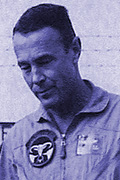

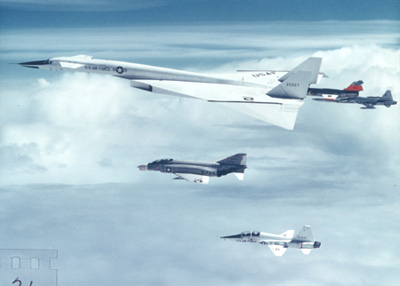
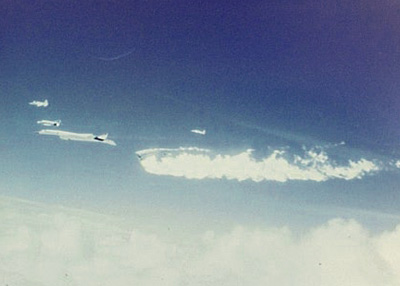
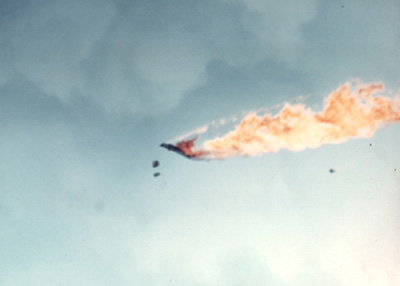
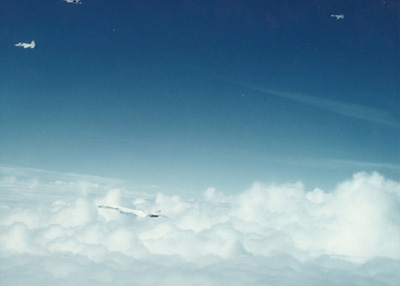
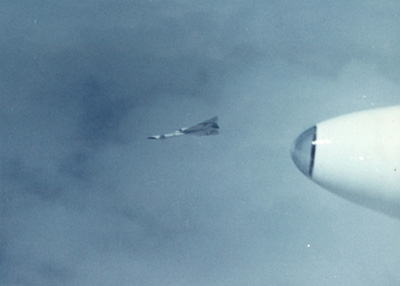
.jpg)